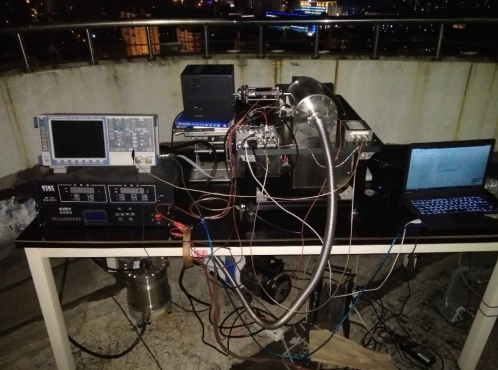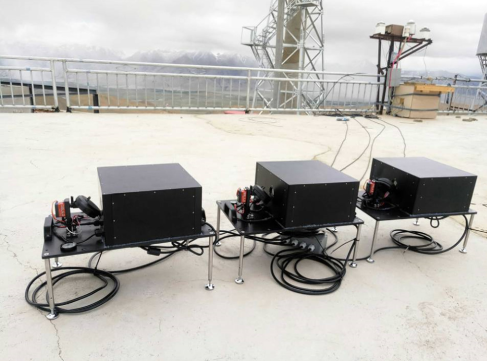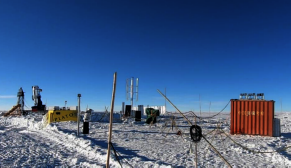Infrared observation is a powerful tool for astronomical research. Unfortunately, for a long time, the development of infrared astronomy observation in China is limited by the lack of excellent sites for infrared observing facilities and detectors. With the continuous expansion of the field of astronomical research in China, the desire of the Chinese astronomical community to have infrared astronomical observation equipment is even more urgent. Recently, a number of large-scale optical infrared astronomical observation equipment projects in China have received support from the astronomical community, including the promoting construction of the 12-meter Large Optical/Infrared Telescope (LOT), the 2.5-meter Kunlun Dark Universe Survey Telescope (KDUST), etc.
Nonetheless, only sites with weak sky background infrared radiation are appropriate for infrared observations. Many important properties of infrared telescopes are constrained by background radiation intensity, such as the depth of the survey, the limit stars that can be observed, and the exposure time of the astronomical imaging system. Furthermore, the local near-infrared background radiation average intensity and variation parameters are important references for evaluating whether a candidate site is suitable for the construction of corresponding equipment. Thus, it is necessary to conduct long-term measurement and obtain relevant measurement data for major domestic observing stations such as Tibet Ali, Xinjiang Mustag, Sichuan Daocheng, and Antarctic Kunlun Station.
In order to supplement the site survey data, a research group led by Associate Professor WANG Jian from the State Key Laboratory of Particle Detection and Electronics, Department of Modern Physics in USTC, in cooperation with Professor ZHU Qingfeng from the Department of Astronomy in USTC, and researchers from National Astronomical Observatories and Polar Research Institute of China, designed a multiband near-infrared sky brightness monitor (MNISBM) using an InSb detector in 2016. The MNISBM comprised of optics, mechanics, cryocooling system, high gain readout electronics, and automatic operational software was tested on the roof of the highest building in the east campus of USTC, which successfully acquired the data of J, H, Ks bands of sky brightness. This work was published in Review of Scientific Instruments.

The test site in the east campus of USTC, Hefei, China. (Image by DONG Shucheng)
Though the above mentioned InSb-based detector is a valuable work, there still remain deficiencies because the operation of such a system requires the use of vacuum technology, cryogenic technology, and cryogenic electronics. The consequent high power consumption and the large volume of this system are unfavorable for field observation. According to the detection advantages of InGaAs detectors on the J, H, and K bands, the near-infrared skylight background measuring instrument for the South Pole was completed based on InGaAs detector in 2017. The test was conducted at the Ali Observator in Tibet in July 2017 and obtained the background data of the first batch of Ali’s near-infrared skylight. The data showed that the background intensity of the near-infrared skylight in the sunny light was weak, proving that such a system is fully capable of carrying out long-term monitoring missions. Related research result was published in Journal of Astronomical Telescopes, Instruments, and Systems.

NISBM installed at the Ngari Observatory. (Image by TANG Qijie)
The story does not stop here. In 2018, the team made improvements on the optics, the noise performance of electronics, the electronic control system, and the automatic observing system. At this time, the monitor is facing the challenge from harsher environmental conditions such as extremely low temperature, high altitude, low pressure and power shortage in Antarctica. On January 23rd, 2019, the monitor was successfully installed at Antarctic Kunlun Station, signifying that the first domestically built near-infrared sky brightness monitor is successfully put into operation in Antarctica.

Installation site at Antarctic Kunlun Station. (Image by State Key Laboratory of Technologies of Particle Detection and Electronics)
This work was fund by the Innovation Team Cultivation Fund of the University of Science and Technology of China, the Important Direction Cultivation Fund, and the National Natural Science Foundation of China and the Chinese Academy of Sciences.
Article Links: https://aip.scitation.org/doi/10.1063/1.5010819
https://www.spiedigitallibrary.org/journals/Journal-of-Astronomical-Telescopes-Instruments-and-Systems/volume-4/issue-04/046002/Design-of-a-near-infrared-sky-brightness-monitor-and-field/10.1117/1.JATIS.4.4.046002.full
(Written by WU Qiran, edited by SHI Xiao, USTC News Center)